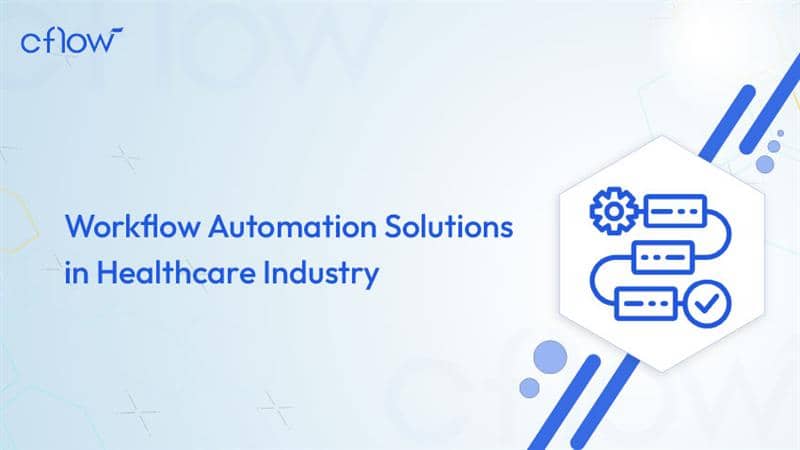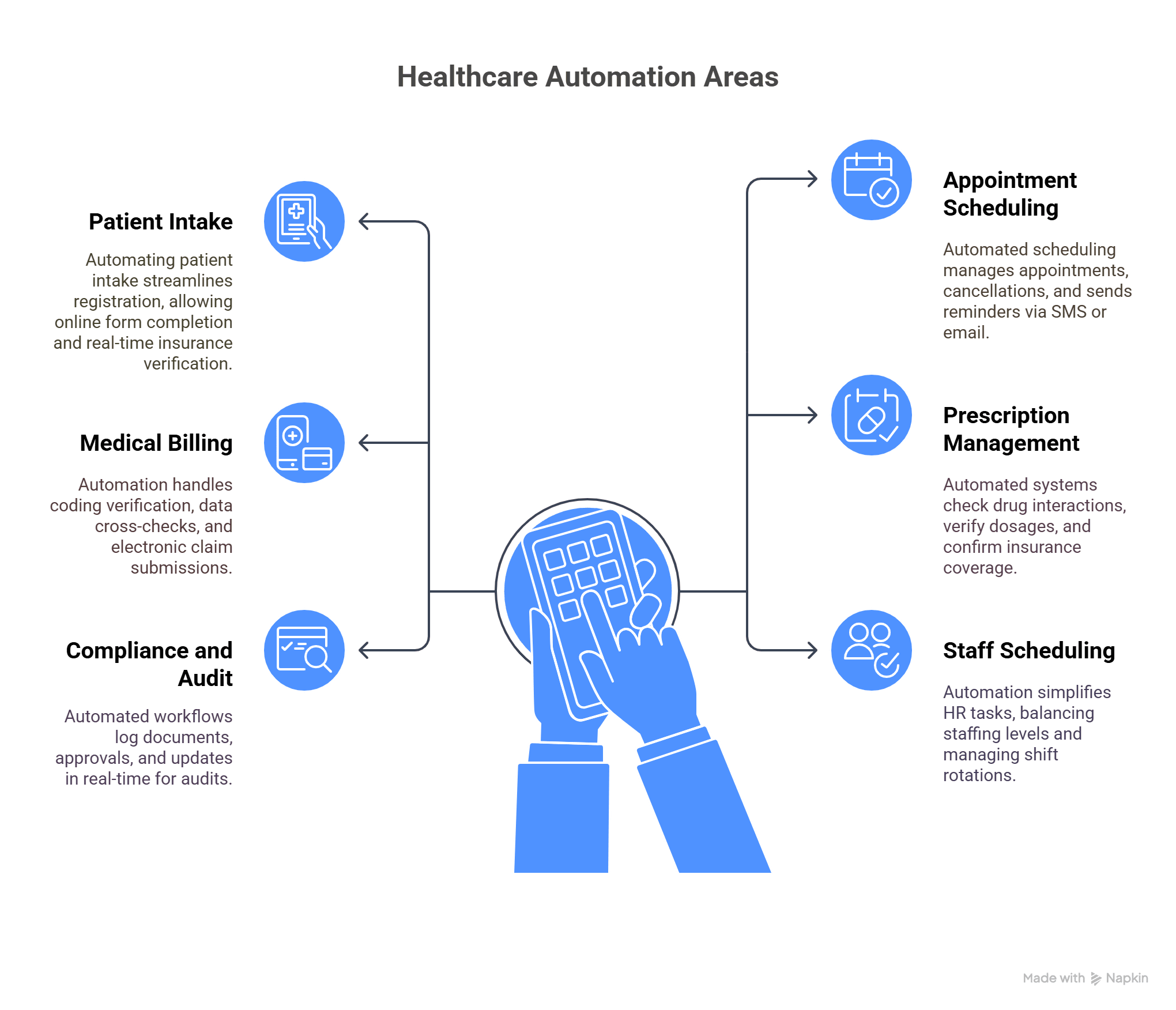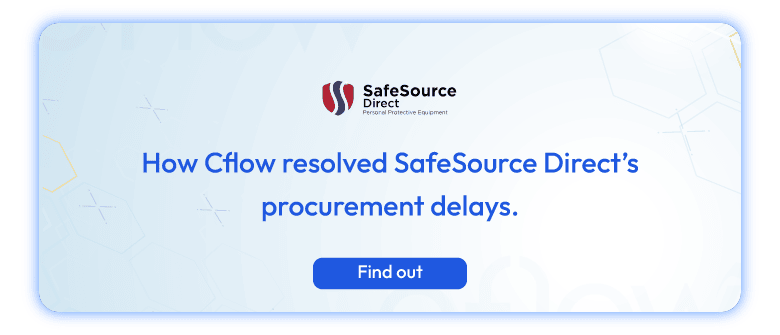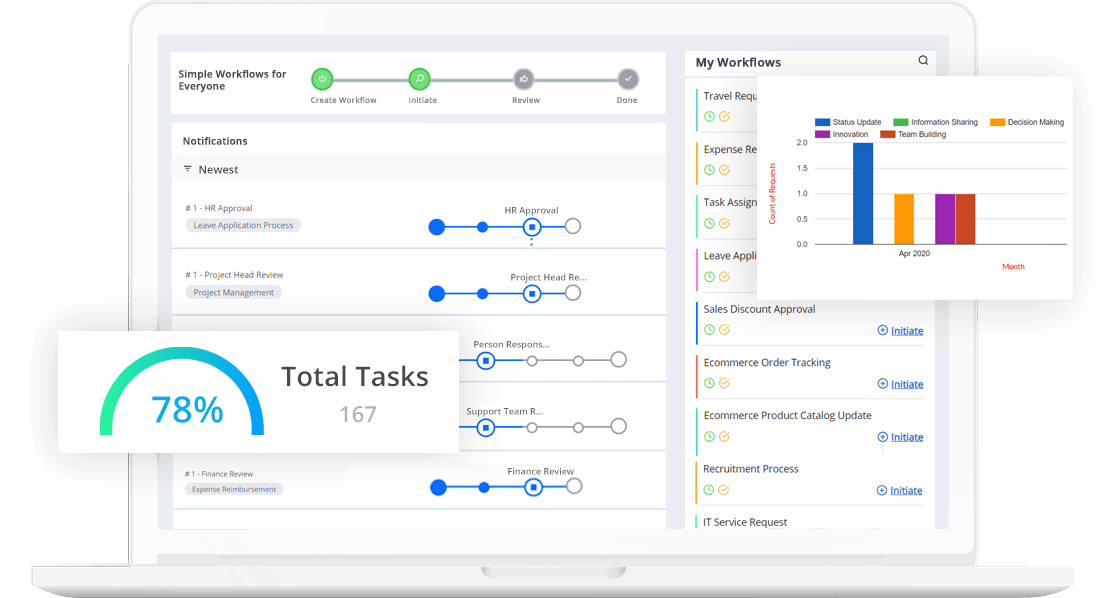Workflow Automation Solutions in Healthcare

Key takeaways
Workflow automation in healthcare eliminates repetitive manual tasks, allowing staff to focus more on patient care and safety.
Automation improves critical processes like patient intake, appointment scheduling, billing, claims processing, and regulatory compliance.
High administrative burden, staff burnout, and rising operational costs are major challenges that automation helps to overcome.
Emerging trends such as AI-powered decision support, predictive analytics, RPA, and patient-centric portals are shaping the future of healthcare automation.
Cflow’s no-code automation platform empowers healthcare organisations to digitise complex workflows easily, improving efficiency and reducing compliance risks.
What is Workflow Automation in Healthcare?
Workflow automation in healthcare is the use of digital tools to streamline and manage clinical, administrative, and operational tasks without manual effort. It replaces repetitive activities with intelligent, rule-based systems that ensure consistency, accuracy, and efficiency across healthcare processes.
This approach is commonly used for automating patient intake, insurance verification, appointment scheduling, billing, and prescription management. By using software to handle these routine tasks, healthcare organisations reduce delays, minimise human error, and improve overall patient care.
For example, when a patient books an appointment online, the system can automatically verify insurance details, assign a doctor, send confirmation messages, and generate intake forms. All of this happens instantly without staff intervention.
Workflow automation helps hospitals, clinics, and health systems improve service delivery, stay compliant with healthcare regulations, and create a more connected and responsive care experience for patients.
Why Healthcare Teams Struggle and How Automated Workflows Help?
Healthcare organisations today face a constant battle against inefficiency, errors, and rising workloads. Many of these struggles come from outdated manual processes that slow down operations and frustrate staff. This section breaks down the most common pain points and shows how workflow automation can solve them clearly, quickly, and at scale.
1. Too Much Time Wasted on Manual Tasks
Is your staff spending hours each day filling out forms, updating spreadsheets, or duplicating data across systems? These tasks aren’t just tedious, they lead to errors, delays, and rising labour costs.
With workflow automation, data is captured once and shared across systems instantly—no copy-pasting, no manual errors.
2. Onboarding Patients Takes Too Long
New patient registrations often involve paper forms, waiting in line, and manual insurance checks. This creates a poor first impression and slows down care.
Automated onboarding collects patient details online, verifies insurance in real time, and preps records before the appointment.
3. Departments Don’t Share Information Smoothly
When communication between lab, pharmacy, billing, and doctors happens over emails or phone calls, critical steps get delayed. This lack of coordination impacts both patient outcomes and internal efficiency.
Automation ensures every task is automatically routed to the right person with clear timelines and updates.
4. Appointment Scheduling Is Full of Gaps
Missed appointments, overbooked slots, and constant rescheduling cost time and money. Manual scheduling doesn’t scale, especially when dealing with high patient volumes.
Automated scheduling tools send reminders, auto-fill calendar gaps, and reduce no-shows significantly.
5. Claims Keep Getting Rejected
Incorrect or incomplete insurance claims are a leading cause of delayed reimbursements and revenue loss. When handled manually, even small oversights result in denied claims and rework.
Workflow automation checks claims for completeness, ensures proper coding, and flags issues before submission.
6. Audits Are a Mad Rush
When a compliance audit hits, pulling together records and activity logs becomes an all-hands scramble. If your processes aren’t traceable, you’re at risk of non-compliance.
With automation, every step is logged, timestamped, and documented—making audits fast and stress-free.
7. Prescriptions Are Slowing Down the Workflow
Doctors still relying on handwritten prescriptions or back-and-forth approvals delay patient treatment. Pharmacy staff may wait hours for clarification or signatures.
Automated prescription workflows ensure orders are approved, routed, and fulfilled without delays or confusion.
8. Billing Delays Hurt Cash Flow
When charges aren’t recorded accurately or invoices are generated late, your revenue cycle suffers. You lose track of services rendered and miss follow-ups.
Automation triggers billing events based on workflows—every charge is captured, coded, and billed on time.
9. Your Team is Overwhelmed and Underproductive
When clinical teams spend more time on paperwork than on patients, burnout increases. It also limits your ability to scale without hiring more staff.
By automating repetitive tasks, your team can focus on care quality, not admin burden.
10. You Can’t See Where the Delays Are
Without real-time tracking, it’s hard to identify bottlenecks or fix broken processes. Decisions are based on guesswork rather than data.
Workflow automation platforms offer dashboards and reports that show task status, turnaround times, and workload in real time.
Why is Workflow Automation Critical for the Healthcare Industry?
The healthcare industry deals with constant pressure. More patients to treat, strict regulations to follow, limited staff, and rising costs. Managing all of this with manual processes makes daily operations slower and increases the risk of mistakes, which can affect patient care.
Workflow automation helps solve many of these problems. By automating routine tasks like data entry, appointment scheduling, billing, and reporting, healthcare teams can reduce errors and save time. This allows doctors, nurses, and administrative staff to focus more on patient care rather than getting tied up with paperwork.
Automation also plays a key role in meeting compliance standards such as HIPAA, GDPR, and NHS regulations. Automated workflows create accurate records, maintain data security, and give teams easy access to information when audits or reviews happen, reducing the chance of non-compliance.
In the bigger picture, automation helps healthcare organisations run more smoothly, handle growing demands, and provide safer, more consistent care to patients. It brings efficiency without sacrificing the quality or safety of medical services.
End-to-end workflow automation
Build fully-customizable, no code process workflows in a jiffy.
Key Statistics Demonstrating the Need for Workflow Automation in Healthcare
Workflow automation is rapidly becoming essential in healthcare, driven by the need to reduce administrative burdens, improve patient care, and enhance operational efficiency. The following statistics highlight the critical challenges and opportunities that underscore why automation is urgently needed in the sector.
1. High Administrative Burden and Inefficiency
- 40% of healthcare workers spend at least a quarter of their work week on manual, repetitive tasks, significantly impacting overall efficiency.
- A survey of NHS and social care managers found 20% spent 7–8 hours a day on administrative work, with 45% saying this burden negatively impacted patient care.
- 24% of healthcare system budgets are allocated to administrative tasks, such as handling faxes, phone calls, and paperwork.
- Hospitals that implement workflow automation report a 30% reduction in administrative workload, freeing staff to focus more on patient care.
2. Financial Impact and Cost-Saving Potential
- The healthcare industry could save upwards of $20 billion annually by automating administrative workflows.
- The healthcare automation market is projected to grow from $42.91 billion in 2025 to $95.53 billion by 2034, reflecting a strong trend toward digital transformation.
3. Error Reduction and Data Quality
- Automating data entry and patient record management leads to 50–80% fewer errors compared to manual processes, directly improving patient outcomes and reducing the risk of medical mistakes.
- Manual, paper-based records are prone to misplacement and damage, leading to incomplete or inaccurate patient information that can hinder diagnosis and treatment.
4. Staff Burnout and Retention Challenges
- 45.2% of physicians report at least one symptom of burnout, often linked to excessive administrative work.
- High attrition rates for administrative roles (20–35% annually) drive up recruitment and training costs, compounding operational challenges.
- Nearly a quarter (22%) of healthcare managers say administrative workload has caused staff to quit, and 24% have considered leaving the field themselves.
5. Patient Experience and Satisfaction
- 81% of healthcare consumers believe that online appointment scheduling would make the process much easier, indicating strong demand for automated solutions.
- Automated patient intake can reduce onboarding time by up to 70%, minimising wait times and improving the patient experience.
6. Compliance, Security, and Data Interoperability
- Workflow automation enables hospitals to ensure 100% compliance with data protection regulations (e.g., HIPAA) by automating access control and encryption, reducing data breach risks.
- Automation enhances data interoperability, allowing seamless sharing and integration of information across systems, which is critical for patient-centric care and regulatory compliance.
7. Impact on Clinical Operations and Outcomes
- Automation in lab result processing can reduce treatment delays by 40%, ensuring clinicians receive critical information faster and can make timely decisions.
- Predictive maintenance of medical equipment through automation improves uptime by 20%, minimising disruptions to patient care.
Impact Metrics of Automation on UK Healthcare Claims Processing
1. Cost Reduction: Automation can reduce healthcare claims processing costs by up to 30% for UK providers and insurers. This figure is based on operational cost savings reported by organisations using AI-powered process automation platforms.
2. Per-Process Savings: UK healthcare providers and insurers have reported savings of up to $80,000 (approximately £63,000) per automated process.
3. Claims Processing Time: Automated healthcare claims software can reduce processing time by as much as 70%, though this figure may vary across organisations.
4. Error and Denial Rate Reduction: Automation reduces manual errors and improves claims accuracy, leading to fewer denials and faster approvals.
5. Fraud Detection: The NHS Counter Fraud Authority estimates that fraud and error cost the UK healthcare system around £1.2 billion per year. AI-driven automation is increasingly used to detect and prevent fraudulent claims, although direct savings figures from fraud reduction are not always specified.
Key Areas Where Workflow Automation Is Transforming Healthcare
Where exactly is automation making a real difference in healthcare? Let’s take a closer look at some of the areas where automated workflows are already changing how healthcare teams work every day.
Patient Intake and Registration
Have you ever noticed how much time is wasted filling out forms at the front desk? Manual registration requires staff to enter details, verify insurance, and update records — all while patients wait. With automation, this whole process becomes smoother. Patients can complete forms online before arriving. The system automatically verifies insurance details and updates electronic health records in real-time. This not only saves time but also reduces errors right from the start.
Appointment Scheduling and Reminders
Scheduling can quickly become a juggling act. What if appointments were managed automatically? Automated scheduling platforms sync directly with doctors’ calendars, handle cancellations, and send reminders to patients through SMS or email. This helps reduce no-shows, keeps schedules organised, and ensures patients get timely care without long waiting periods.
Medical Billing and Claims Processing
Billing mistakes are not only frustrating but also expensive. Automation takes care of coding verification, cross-checks patient data, and submits claims electronically. As a result, claim rejections drop, payment cycles speed up, and staff spend less time fixing billing errors.
Prescription Management
What about prescriptions? Getting medications right is critical. Automated prescription systems check for drug interactions, verify dosages, and ensure that insurance coverage is confirmed before approval. This makes sure patients receive safe and accurate prescriptions while reducing the burden on pharmacists and medical staff.
Compliance and Audit Readiness
Staying compliant is always a challenge. How do you keep up with constant audits and regulations? Automated compliance workflows log every document, approval, and update in real time. This makes audit processes much smoother and helps healthcare organisations meet NHS and regulatory standards with confidence.
Staff Scheduling and HR Workflows
HR tasks often take up more time than expected. From onboarding new staff to managing shift rotations, automation simplifies the entire process. It ensures that staffing levels remain balanced, shift conflicts are avoided, and HR teams aren’t overwhelmed with paperwork.
Speak with our workflow management experts today
Future Trends: Where Healthcare Workflow Automation Is Headed
So, where is healthcare automation going next? As technology keeps evolving, we are seeing newer capabilities that promise to take automation even further, helping both care providers and patients.
AI-Powered Decision Support
AI is starting to assist healthcare teams with real-time decision-making. In the coming years, we’ll see more advanced AI helping doctors with diagnoses, patient triage, and predicting potential health issues before they worsen. This allows earlier interventions and better patient outcomes.
Predictive Analytics
What if hospitals could better predict patient flow and resource needs? Predictive analytics will continue to improve, helping forecast admissions, allocate staff efficiently, and reduce preventable readmissions. This leads to smoother hospital operations and better care planning.
Interoperability
One major challenge is still data sharing between systems. The future lies in building stronger integration between hospitals, labs, pharmacies, and insurance companies. With better interoperability, healthcare teams can access complete patient data instantly, cutting delays and improving care coordination.
The Next Phase of RPA
Robotic Process Automation is already helping with routine tasks like billing, data entry, and claims processing. In the future, RPA will become even smarter. It will handle more complex tasks, adapt to changing workflows, and work alongside AI to make administrative work even faster and more accurate.
Patient-Centric Portals
Patients want to feel more in control of their care. In the near future, self-service portals will offer even more features, allowing patients to book appointments, access test results, communicate with doctors, and manage payments all from one place. This creates a better patient experience and reduces administrative load.
Transform your AI-powered approvals
How Cflow Helps with Healthcare Workflow Automation
Cflow’s no-code platform offers healthcare organisations a practical way to automate workflows without complex IT projects or expensive custom development. Here’s how Cflow fits into various healthcare processes:
- Patient Onboarding Automation: Patients complete forms online; Cflow routes data to EHRs, verifies insurance, and alerts relevant staff.
- Appointment Management: Cflow schedules appointments based on provider availability, sends reminders, and manages rescheduling requests.
- Billing and Claims Submission: The platform integrates with billing systems to validate codes, compile claims, and track payment status.
- Regulatory Compliance: Cflow logs every step for easy audit trails, ensuring NHS, GDPR, and healthcare-specific compliance.
- Clinical Workflow Coordination: Care team task lists, lab orders, and approvals are routed automatically, reducing delays.
- Supply Chain and Inventory Management: Procurement requests, stock monitoring, and supplier approvals flow smoothly with automated workflows.
- HR and Credentialing: Staff onboarding, training tracking, and credential verification become fully automated, reducing HR workload.
How Seyarc AI Supercharges Workflow Automation in Cflow
Cflow integrates Seyarc AI to make building workflows even simpler and smarter. Instead of manually configuring every step, users can just type a simple prompt or upload a detailed document describing the process they want to automate. Seyarc AI helps by guiding you through the process, providing suggestions, and offering the most suitable solutions based on your needs. Once you finalise the input, the AI automatically creates the entire workflow, mapping out the steps, rules, and approvals needed. That’s great, right? With this approach, healthcare teams can build complex workflows in minutes without needing technical expertise. This makes it much easier to drive digital transformation across clinical, administrative and operational processes.
Unleash the full potential of your AI-powered Workflow
Case Studies: How Cflow Transformed Healthcare and Administrative Workflows
These real-world case studies highlight how Cflow helped organisations eliminate manual processes, accelerate approvals, and bring new levels of efficiency to healthcare operations and support functions.
1. SafeSource Direct: Cutting Procurement Delays with Instant Digitisation
SafeSource Direct, a supplier of medical and surgical products, was heavily reliant on a manual purchase requisition process. Every approval went through paper forms and lengthy email chains, which led to frustrating procurement delays. This affected not only their internal teams but also the timely delivery of critical medical supplies to healthcare providers.
Once Cflow was implemented, the entire purchase requisition workflow was digitised in just two days. Within a month, multiple additional processes were automated, eliminating repetitive work and freeing up staff to focus on higher-value tasks. The end result was a streamlined operation with improved speed, accuracy, and productivity.
2. BlueBin: Streamlining Purchase Orders in Healthcare Logistics
BlueBin, a logistics provider serving hospitals and healthcare organisations, struggled with inefficient purchase order approvals. Paper forms and spreadsheets slowed down the entire process, delaying essential medical supply deliveries.
Cflow’s automation solution transformed BlueBin’s PO creation process by digitising the paper-based forms and automatically generating and routing POs to the correct vendors. This not only sped up procurement but also ensured that hospitals received necessary supplies without unnecessary administrative holdups, which is critical for smooth healthcare operations.
Top Workflow Automation Software For Healthcare
Explore the leading workflow automation tools trusted by healthcare teams to simplify complex processes and improve operational efficiency.
1. Cflow
Cflow is a powerful AI-powered no-code workflow automation platform used across industries, including healthcare, finance, education, and manufacturing. It enables organisations to automate complex administrative, operational, and compliance workflows without coding. With full GDPR compliance, intuitive visual builders, and AI assistance (via Seyarc AI), Cflow simplifies workflow automation while ensuring scalability, security, and efficiency for businesses of all sizes.
Features:
- Visual Workflow Builder for easy process design
- Drag-and-Drop Form Designer for custom forms
- Seyarc AI-powered workflow generation
- Integration capabilities with EHR, billing, and compliance systems
- Mobile accessibility for staff on the go
Pros:
- Easy for non-technical users to build healthcare workflows
- Strong data security and GDPR compliance
- Highly scalable across multiple healthcare departments
Cons:
- Limited features in the basic plan
2. Keragon
Keragon is a no-code healthcare automation platform designed specifically for highly regulated sectors like NHS and private healthcare. It allows providers to build AI-assisted workflows without coding, integrating hundreds of healthcare apps seamlessly. Its strong HIPAA/GDPR compliance makes it ideal for UK healthcare data security standards.
Features:
- Visual no-code workflow builder
- AI co-pilot for design & troubleshooting
- 300+ healthcare tool integrations
- HIPAA/GDPR compliance
- Rapid deployment (often within 60 minutes)
Pros:
- Extremely fast workflow setup
- Powerful AI guidance
- Robust privacy/security compliance
Cons:
- May require support for complex workflows
- Pricing tailored to healthcare — may be steeper
- Learning curve for non-technical users
3. FlowForma
FlowForma is a UK-based no-code workflow platform widely adopted across NHS trusts to automate administrative, HR, clinical, and compliance processes. Its drag-and-drop builder simplifies digitisation for healthcare teams without IT dependency. The platform offers strong governance and reporting to meet NHS audit standards.
Features:
- Drag-and-drop workflow & form builder
- AI-assisted Copilot
- Built-in analytics & document generation
- Open API integrations
- Mobile-enabled interfaces
Pros:
- User-friendly for non-technical staff
- Strong support for NHS requirements
- Excellent governance and audit capabilities
Cons:
- May lack advanced AI features
- Interface can feel dated
- Requires thoughtful planning for complex automations
4. Datasumi
Datasumi offers AI-powered automation for healthcare processes like document handling, reporting, inventory, patient scheduling, and claims processing. It’s G-Cloud listed and designed to support NHS organisations modernising back-office and clinical workflows. Its AI focus helps healthcare providers reduce errors and improve data-driven decisions.
Features:
- Automated document processing
- Intelligent reporting/real-time analytics
- Inventory & supply-chain automation
- Patient scheduling support
- Claims/EHR integration
Pros:
- Broad scope of healthcare processes covered
- Error reduction via AI
- Integrates admin, clinical, and logistics workflows
Cons:
- AI quality depends on data context
- May require significant setup and support
- Pricing and support complexity on G-Cloud
5. mpro5
mpro5 is a mobile-first platform widely used by hospitals, care homes, and NHS facilities to manage operational workflows, compliance tasks, and daily checklists. It enables healthcare teams to capture evidence, monitor IoT devices, and ensure quality standards on the go. Ideal for facilities and operational compliance.
Features:
- Configurable mobile checklists
- Real-time IoT sensor data
- Compliance and evidence logging
- Task scheduling & staff coordination
- Analytics & reporting dashboards
Pros:
- Excellent for mobile and field-based work
- Increases visibility and accountability
- Tight compliance support with audit trails
Cons:
- Best suited for operational tasks, not full workflows
- Dependent on mobile device deployment
- Integration with EHR systems may need custom work
6. Lantum
Lantum is purpose-built for NHS clinical staffing workflows, automating rota planning, staff coordination, and payments across GP practices, hospitals, and vaccination centres. It helps NHS trusts save millions by improving workforce management efficiency. Its adoption is growing rapidly across UK healthcare staffing networks.
Features:
- Automated rota scheduling
- Locum/temporary staff coordination
- Invoicing & payments automation
- Reporting & workforce analytics
- Integration with NHS trust systems
Pros:
- Huge cost savings & efficiency gains
- Ideal for workforce-heavy environments
- Proven NHS adoption and ROI
Cons:
- Focused solely on staffing workflows
- Not suited for non-staffing processes
- Smaller ecosystem compared to broader platforms
Conclusion
At the end of the day, healthcare is about people and that’s exactly where workflow automation makes the biggest difference. By taking routine tasks off the hands of doctors, nurses, and admin teams, automation frees them up to focus on patient care. Whether it’s faster patient intake, smoother billing, or fewer scheduling headaches, automated workflows bring much-needed simplicity to complex healthcare environments. With workflow solutions like Cflow leading the charge, healthcare providers can confidently embrace automation to improve efficiency, minimise errors, and build more resilient, patient-centred systems ready for the future.
Sign up for Cflow today and explore how easy it is to automate your healthcare workflows.
Get the best value for money with Cflow
FAQs
1. What are the three types of workflow?
Administrative, clinical, and operational workflows are commonly used in healthcare to streamline tasks, improve care, and manage resources efficiently.
2. What are the benefits of automating EHR workflow templates?
Automation of EHR templates reduces documentation errors, improves data accuracy, saves clinician time, and enhances patient care coordination.
3. What are the issues with workflow in healthcare?
Common issues include manual data entry, fragmented systems, communication delays, and compliance risks, all leading to inefficiency and errors.
4. What is the difference between workflow automation and RPA?
Workflow automation handles end-to-end processes based on business rules, while RPA focuses on automating individual repetitive tasks within workflows.
5. What is an intelligent automated workflow?
It combines AI, analytics, and automation to make dynamic, data-driven decisions within workflows, improving accuracy, speed, and outcomes.
Related Articles:
- What is Workflow Automation in Healthcare
- Healthcare Claims Processing Workflow Automation
- 5 Steps For An Effective Process Workflow Automation
Thanks for reading till the end. Here are 3 ways we can help you automate your business: Create workflows with multiple steps, parallel reviewals. auto approvals, public forms,
etc. to save time and cost. Get a 30-min. free consultation with our Workflow expert to optimize
your daily tasks. Explore our workflow automation blogs, ebooks, and other resources to master
workflow automation. Automate your workflows with our Cflow experts.What should you do next?

Do better workflow automation with Cflow

Talk to a workflow expert

Get smarter with our workflow resources
What would you like to do next?
Get Your Workflows Automated for Free!






